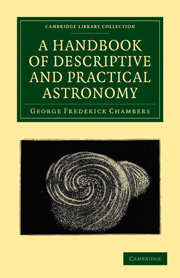Book contents
- Frontmatter
- PREFACE
- SUPPLEMENT
- Contents
- LIST OF ILLUSTRATIONS
- PRINCIPAL AUTHORITIES
- Errata
- A Handbook of Descriptive and Practical Astronomy
- BOOK I A SKETCH OF THE SOLAR SYSTEM
- CHAPTER I THE SUN
- CHAPTER II THE PLANETS
- CHAPTER III VULCAN
- CHAPTER IV MERCURY
- CHAPTER V VENUS
- CHAPTER VI THE EARTH
- CHAPTER VII THE MOON
- CHAPTER VIII MARS
- CHAPTER IX THE MINOR PLANETS
- CHAPTER X JUPITER
- CHAPTER XI SATURN
- CHAPTER XII URANUS
- CHAPTER XIII NEPTUNE
- BOOK II ECLIPSES AND THEIR ASSOCIATED PHENOMENA
- BOOK X METEORIC ASTRONOMY
- APPENDICES
- INDEX TO SUBJECTS
- INDEX TO NAMES
- Plate section
CHAPTER IV - MERCURY
Published online by Cambridge University Press: 05 July 2011
- Frontmatter
- PREFACE
- SUPPLEMENT
- Contents
- LIST OF ILLUSTRATIONS
- PRINCIPAL AUTHORITIES
- Errata
- A Handbook of Descriptive and Practical Astronomy
- BOOK I A SKETCH OF THE SOLAR SYSTEM
- CHAPTER I THE SUN
- CHAPTER II THE PLANETS
- CHAPTER III VULCAN
- CHAPTER IV MERCURY
- CHAPTER V VENUS
- CHAPTER VI THE EARTH
- CHAPTER VII THE MOON
- CHAPTER VIII MARS
- CHAPTER IX THE MINOR PLANETS
- CHAPTER X JUPITER
- CHAPTER XI SATURN
- CHAPTER XII URANUS
- CHAPTER XIII NEPTUNE
- BOOK II ECLIPSES AND THEIR ASSOCIATED PHENOMENA
- BOOK X METEORIC ASTRONOMY
- APPENDICES
- INDEX TO SUBJECTS
- INDEX TO NAMES
- Plate section
Summary
Owing to its proximity to the Sun, observations of the physical appearance of this planet are obtained with difficulty, and even then are liable to much uncertainty. Schröter, who paid considerable attention to Mercury, thought he had detected traces of the existence of high mountains on its surface; his observations, however, were not confirmed by Sir W. Herschel. Mercury exhibits phases similar to those of the Moon. At its maximum elongations, only half its disc is illuminated, but as it approaches its superior conjunction, the breadth of the illuminated part increases, and its form becomes gibbous, and ultimately circular in conjunction, when, however, the planet is lost in the Sun's rays and invisible; on emerging, the gibbous form is still preserved, but the gibbosity is on the opposite side. The breadth of the illuminated part diminishes as the planet draws near its greatest elongation, when it again appears like a half moon, and continues to become more and more crescented as it approaches the inferior conjunction; having passed this, the crescent (now on the opposite side) gradually increases until the planet again reaches its greatest elongation.
- Type
- Chapter
- Information
- A Handbook of Descriptive and Practical Astronomy , pp. 32 - 33Publisher: Cambridge University PressPrint publication year: 2010First published in: 1861

